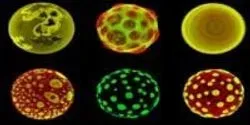Cell Biology

Thawing cells in a regulated environment presents many challenges. The need to minimize variability through standardization is crucial. Whereas the science of cell freezing has become highly standardized in order to improve and retain optimal viability and function, cell thawing has been overlooked and has much to gain from similar standardization.

A team led by structural biologists at The Scripps Research Institute (TSRI) has taken a big step toward understanding the intricate molecular mechanism of a metabolic enzyme produced in most forms of life on Earth.

It was the yellow color of the solution, pulled from cauliflower, that set Frederick Crane’s hallmark achievement into its final motion.

A novel looping mechanism that involves the end caps of DNA may help explain the aging of cells and how they initiate and transmit disease, according to new research from UT Southwestern Medical Center cell biologists.

How did life originate? And can scientists create life? These questions not only occupy the minds of scientists interested in the origin of life, but also researchers working with technology of the future. If we can create artificial living systems, we may not only understand the origin of life - we can also revolutionize the future of technology.

If cells were cars, then the three pioneering cell biologists just named winners of the 2014 E.B. Wilson Medal, the highest scientific honor of the American Society for Cell Biology, helped write the essential parts list. William "Bill" Brinkley of the Baylor College of Medicine in Houston, John Heuser of the Washington University School of Medicine in St. Louis, and Peter Satir of the Albert Einstein College of Medicine in the Bronx identified crucial pieces of the cytoskeleton, the cell's shape-shifting framework, and showed how these elements drive life at the cellular level.











